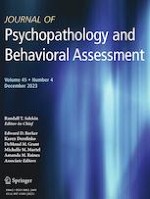06-10-2023
The Substance Use Risk Profile Scale in Adulthood: An Exploratory Structural Equation Modelling Approach
Gepubliceerd in: Journal of Psychopathology and Behavioral Assessment | Uitgave 4/2023
Log in om toegang te krijgenAbstract
Background
The substance use risk profile scale (SURPS) was developed to assess four personality risk factors: hopelessness, anxiety sensitivity, impulsivity, and sensation seeking. Psychometric validation work—mainly with adolescents and emerging adults—has struggled to support a four-factor simple structure without post-hoc modifications. This study aimed to clarify the factor structure of the SURPS using the most appropriate analytic framework in a sample of adults and investigate its ability to predict various alcohol-related outcomes and motives.
Methods
Adult participants (N = 400; Mage = 32.05, 55% male) completed the SURPS and measures capturing drinking habits and motives. Confirmatory factor analytic (CFA) and exploratory structural equation modeling (ESEM) approaches were used to analyze the dimensionality of the SURPS items, with measurement invariance examined across gender and age. Predictive validity was analyzed using multiple linear regression with observed subscale scores.
Results
Following poor fit of a traditional CFA model with four correlated factors, a four-factor ESEM model (allowing for non-zero item cross-loadings) provided a much stronger fit to the SURPS data. This ESEM model also had scalar invariance across age and gender. Observed subscale scores predicted hypothesized drinking motives. Sensation seeking uniquely predicted hazardous alcohol use while hopelessness, anxiety sensitivity, and sensation seeking uniquely predicted alcohol-related problems.
Conclusion
SURPS model fit was substantially better when using a contemporary ESEM approach. This approach tackles the challenge of CFA being too constraining when faced with the reality of item responses being influenced by correlated clinical constructs.
